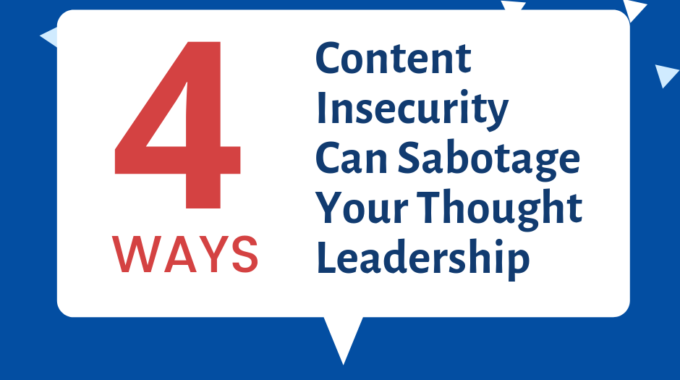Hey, thought leaders! I want to tell you about a powerful approach to thought leadership…
Four Ways Content Insecurity Can Sabotage Your Thought Leadership
In the past, we’ve talked a little bit about content insecurity. Content insecurity happens when a thought leader can’t stop tweaking their content. They often ask, “Is my content ready to stand on its own?” Suffering from content insecurity is a problem, and it leads to bad habits that can really cut a thought leader down.
Content insecurity can make smart people do unproductive things, like:
- Delay their work,
- Contradict themselves,
- Sabotage themselves in front of clients, and
- Start projects, but never finish them.

Delay
Content insecurity delays a thought leader’s work. They’re convinced that they need to do more research, write another paper, read more interviews, or do more deep thinking. They may decide to expand and expand to cover “everything” rather than focusing on their best ideas.
Contradictions
I worked with one thought leader that gave his clients a workbook, then not only ignored the information in that workbook – he actively contradicted it! “Don’t look at the list on page seven. Instead . . .” His audience was constantly being told to ignore things they’d already learned, and try something else!
Self-Sabotage
Another bad habit that stems from content insecurity is self-sabotage. If you’re not confident in your work, you audience won’t be, either. You’ll end up apologizing for your content and sabotaging your best ideas. And if they see that, your clients will start worrying if they’ve made a bad decision bringing you in. Self-sabotage not only undermines a thought leader’s content, it also destroys the leader’s credibility as an expert.
Loose Ends
Content insecurity often causes a thought leader to doubt a project’s viability. They start creating products, but rarely finish anything. They have great ideas, they know their content can be helpful to people, but they never trust an asset enough to let go.
A thought leader’s content insecurity can be a source of constant tension. Mother birds occasionally have to push their babies out of the nest, and in that vein, a thought leader needs to realize when it’s time to let their content speak for themselves. Avoid these four bad habits, and trust your ideas. You can fly – and your content can, too!




